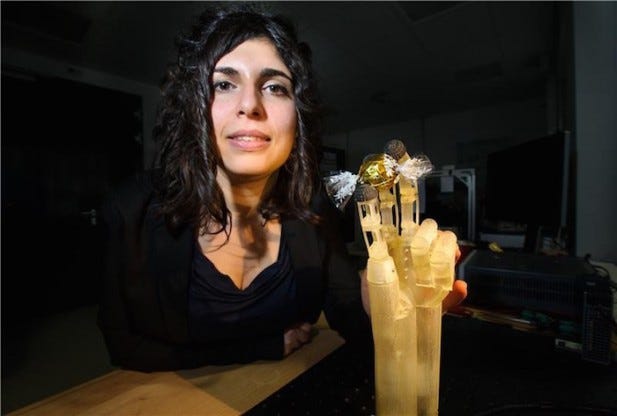Metallic Muscles Flex in This Artificial Hand
March 26, 2015
Bundles of hair-thin nitinol enable the fingers of a robotic hand to contract and release.
Brian Buntz
|
Doctoral student Filomena Simone helped develop the hand prototype. |
Researchers at Saarland University (Saarbrücken, Germany) have developed a lightweight artificial hand capable of carrying out precise motions that uses tiny bundles of nitinol for actuation. The hand is light and flexible, and is devoid of motors, pulleys, pneumatics, or other conventional mechanical components that add heft to conventional artificial hands.
While nitinol has been used for some time as an actuator, owing to its shape-memory properties, they have used in fairly simple applications. Still, the roster of complex applications has been steadily expanding, and now includes FDA-approved medical devices, camera shutters, and the Mars Rover. In 2008, a YouTube video of a nitinol-actuated finger appeared. A year later, Mexican researchers came up with a simple nitinol-based hand.
Shape-memory alloys like nitinol can contract like in the range of 2-5% when electrically driven or heated. They also happen to be well suited for use as muscles in artificial hands, according to Saarland University professor Stefan Seelecke. They operate silently, unlike motor-actuated artificial hands, and also have a relatively low price point. "And these wires have the highest energy density of all known drive mechanisms, which enables them to perform powerful movements in restricted spaces," he adds.
To create their hand prototype, the researchers mimicked the human hand's anatomy, using a series of strands of the alloy to serve as flexor and extensor muscles and to link finger joints.
The resulting hand boasts articulation similar to that of a human hand and, because of the strength of nitinol, the hand can quickly contract and relax with high tensile force, according to Filomena Simone, a researcher at Saarland University working towards her doctorate. 'The reason for this behavior is the rapid cooling that is possible because lots of individual wires present a greater surface area through which heat can be dissipated," she says in a statement. "Unlike a single thick wire, a bundle of very fine wires can undergo rapid contractions and extensions equivalent to those observed in human muscles. As a result, we are able to achieve fast and smooth finger movements,' she explains.
The scientists used a semiconductor chip to enable the hand to offer precise movements without the need for sensors. "The material from which wires are made has sensor properties. The controller unit is able to interpret electric resistance measurement data so that it knows the exact position of the wires at any one time," Seelecke explains.
The researchers are looking for partners to help commercialize the technology and are also working to improve the hand's ability to imitate the natural movements of the human hand.
Learn more about cutting-edge medical devices at BIOMEDevice San Jose, December 2-3. |
Brian Buntz is the editor-in-chief of MPMN and Qmed. Follow him on Twitter at @brian_buntz.
Like what you're reading? Subscribe to our daily e-newsletter.
About the Author(s)
You May Also Like



